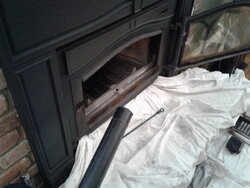 For the first time I cleaned my chimney “bottom up “ with a sooteater today. It was safer and warmer than going up on a lader in January. I have to say it took about the same amount of time (I was taking my time though). Slightly more messy. The sooteater did a good job.
For the first time I cleaned my chimney “bottom up “ with a sooteater today. It was safer and warmer than going up on a lader in January. I have to say it took about the same amount of time (I was taking my time though). Slightly more messy. The sooteater did a good job. If it was not for this site, I would not know such a tool existed.



